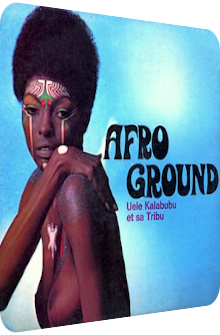
Uele Kalabubu
Afroground
1969
It is easy today to pre-listen to albums or quasi-watch an uploaded “video” of an esoteric long-forgotten track on YouTube, but back then, the front artwork alone didn’t necessarily say anything about the quality, and neither did the boastful liner notes. Cry me a river. A river of joy, for mystic man Uele Kalabubu’s Afroground is a great work on so many intrinsic and exogenous levels that it is likely to be missed even by the devoted Exotica fan. Released in 1969 on a battery of different labels, among them Columbia, Phillips and Polydor, this is a hidden classic, sporting 12 original compositions. From the outside, it looks as if Afroground is another tame record by a European group of musicians from Germany and Belgium who mask their identities behind crazy stage names and wrong identities.
After all, the perfectly North American denizen Chaino provided the blueprint for many a musician in the African music scene, and let’s not forget Korla Pandit whose supposedly genuine Indian heritage is not much more than a pipe organist’s pipe dream. Uele Kalabubu – presumably from the Republic of Congo – provides the real thing though, or something close to the real thing. Featuring djembes, gourds, timbales, marimbas, flutes and a zoetrope of vocals, his men knows how to deliver the goods. Among the tribe are musicians like marimbaphonist and composer Sadi Lallemand aka Fats Sadi, drummers Frédéric Rottier and Stu Martin, composers E. Gilbert and Hunstad who also appear on Roberto Delgado’s African Dancing (1970), and many more. So what is the primary genre or style of Afroground then? You’d be more surprised about what it isn’t, but more about this over the course of this review.
The first glorious signage that Afroground is not your common studio album is dropped in the opener Makelele which starts with Gospel chants as well as playfully savage utterings by the mixed choir. It is then further revved up by a catchy bass guitar and rounded off by the tin sounds of the intermixed timbales. Surprisingly enough, it is the vocals that carry the whole track melody-wise. A funky kick-off with more to come, obviously so: Nina Kwenda Africa outlines the rhythmic physiognomy of a caravan complete with cavernous vocals, focusing on reverberated moonlit vocals accompanied by light gourds, droning timpani and gorgeously silky woodwind aureoles, whereas Sassa Boumbitumba is a smoking-fast drumfest with the green chlorotic hue of rain forest marimbas, jungle fifes, screaming apes and a good-natured fusillade of djembes in tandem with vocals.
Mututo Una Zara meanwhile is the exact opposite, for it basks in warmth and injects a hammock-compatible downbeat structure that is filled with sermonic prosodies, kaleidoscopic marimba droplets and a droning rivulet of bass guitars before the second section sees an increase both in tempo and glee. The adjacent Liambo is another vocal-heavy arrangement that lives from its handclaps, depth of field and oomph of the drums before the mighty Matata creates a luring djembe/timbale punctilio whose tasty maraca-accentuated monotony provides the reliant base for the African singsong. The catchiness of the textures makes it a timeless sparkler and great closure of side A.
It doesn’t come as a surprise that side B lives up to the aesthetic value that unfolded priorly. The primer Baba D’Uele provides the fast vitreous-opaque dichotomy of clanging djembes, Haitian flutes and convoluted alkaloidal chants that is a great addition to a well-working formula. However, it is Patatalo that marks a change of pace and rhythm, providing a pointillistic pluvial beat reign in 3/4 time with chinking tambourines, various drum surfaces and the mutual polyphony of the singers. The chopped discords of the flutes add vivacity to the tangible bond. Tara Din Din then provides an aquatic panorama of benthic driblets, laid-back drum beats whose interstices are filled with nonentity, and withdrawn chants. The legato flutes are almost pentatonic and invoke the spirit of Asia that is – according to the Occidental ear – so often found in such Music and lets mountainous vistas appear before the inner eye.
While Simbalele delineates a sun-dappled and incredibly bustling scenery with an eclectic array of drums, fir-green marimbas and wonderful euphonies within the vocals, Afro-Disiac provides the only pun of the album and is thus a hint of its European origin. Naturally, this piece is a Funk escapade with triangles, tambourines and other plinking devices. Add a recondite bass and frilly flutes to the scenery, and you are hued in dualistic twilight. The finale Kalabubu Uele is a last salute to the tribal togetherness that percolates through every crack of the album. Chants, drums, flutes and marimbas unite in a blithesome apotheosis.
Afroground is a surprise in the true sense of the word due to the fact that its title tells the truth for a change! Exotica as a genre is rarely ever about reality and rather resides in altered worlds, paradisiac viewpoints, transfigurations thereof. If this tendency is applied here, it can only lead to one conclusion: Afroground is no Exotica album. This is not the proclamation that is about to surpise anyone. It is the essence of the following sentence that might achieve this on a small level: Afroground is not even a Funk album! It looks suspiciously like it, what with the cool-blue front artwork. However, this is unlike Martin Denny’s exotic Afro-Desia (1959) or Vecchio’s funky Afro-Rock (1971). It feels genuine and meaningful, features unique material throughout its runtime, never breaks the third wall – with Afro-Disiac being the only transparent witticism – and enthralls with the textures of the drums, not to mention the polyphonic variety of the vocals.
It is refreshing to listen to a work that is prone to deliver wah wah guitars, synthesizers and whatnot, only to then catch the listener off guard by ostracizing this equipment. Then again, Uele Kalabubu freely gives the concept away in the title. It is only due to the fact that so many artists, labels and their marketing machineries misused the power of great titles and linked them to artifacts that aren’t necessarily all too close to the connotative associations they are causing. As such, Afroground is as close to a tribal/ethnic World music album as can be, given that its heritage is somewhere in Belgium, home to Nico Gomez, The Waikikis and even pianist John Evans. Unfortunately, the album remains an incident rather than being part of a series, and so the band’s one-time opportunity is not to be missed, though it was only ever officially released on vinyl.
Exotica Review 422: Uele Kalabubu – Afroground (1969). Originally published on Mar. 28, 2015 at AmbientExotica.com.
